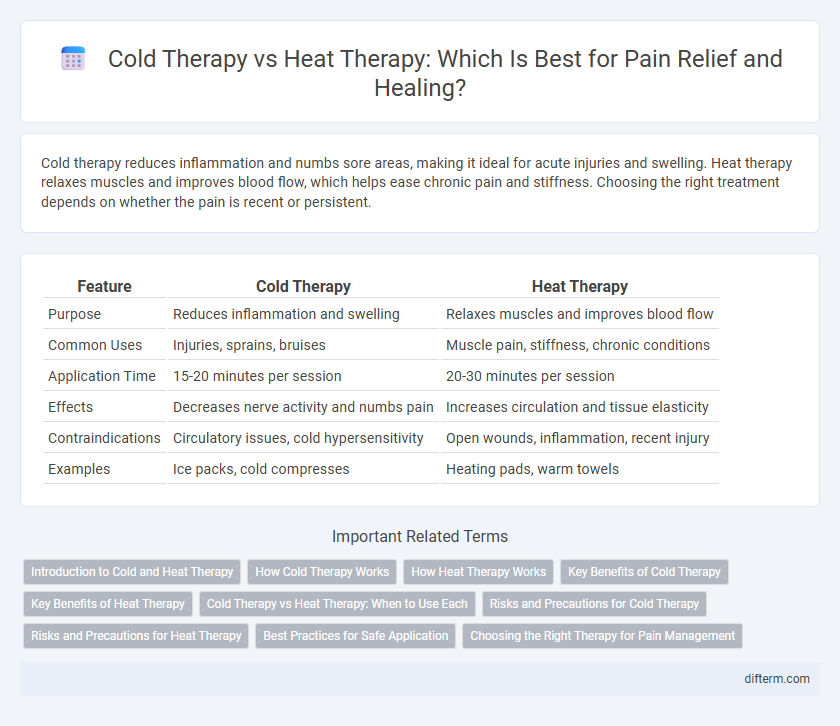Cold therapy reduces inflammation and numbs sore areas, making it ideal for acute injuries and swelling. Heat therapy relaxes muscles and improves blood flow, which helps ease chronic pain and stiffness. Choosing the right treatment depends on whether the pain is recent or persistent.
Table of Comparison
| Feature | Cold Therapy | Heat Therapy |
|---|---|---|
| Purpose | Reduces inflammation and swelling | Relaxes muscles and improves blood flow |
| Common Uses | Injuries, sprains, bruises | Muscle pain, stiffness, chronic conditions |
| Application Time | 15-20 minutes per session | 20-30 minutes per session |
| Effects | Decreases nerve activity and numbs pain | Increases circulation and tissue elasticity |
| Contraindications | Circulatory issues, cold hypersensitivity | Open wounds, inflammation, recent injury |
| Examples | Ice packs, cold compresses | Heating pads, warm towels |
Introduction to Cold and Heat Therapy
Cold therapy reduces inflammation and numbs painful areas by constricting blood vessels, making it effective for acute injuries and swelling. Heat therapy relaxes muscles and increases blood flow, promoting healing in chronic conditions and muscle stiffness. Both therapies target different physiological responses to optimize pain relief and recovery.
How Cold Therapy Works
Cold therapy works by constricting blood vessels, which reduces blood flow to the affected area, thereby minimizing inflammation and swelling. It also numbs nerve endings, providing pain relief by slowing down nerve impulses. This therapeutic approach is particularly effective for acute injuries, muscle spasms, and post-exercise recovery.
How Heat Therapy Works
Heat therapy works by increasing blood flow to targeted areas, which helps relax muscles, reduce stiffness, and alleviate pain. The application of warmth promotes the dilation of blood vessels, enhancing nutrient delivery and accelerating tissue repair. This method is effective for chronic muscle pain, joint stiffness, and injury recovery, providing soothing relief and improving mobility.
Key Benefits of Cold Therapy
Cold therapy reduces inflammation and numbs pain by constricting blood vessels and decreasing nerve activity. It effectively minimizes swelling and muscle spasms, promoting faster recovery after injuries or intense physical activity. Cold therapy also helps prevent tissue damage, making it ideal for acute injuries such as sprains, bruises, and strains.
Key Benefits of Heat Therapy
Heat therapy promotes blood flow and muscle relaxation, accelerating tissue repair and reducing stiffness. It effectively alleviates chronic pain conditions such as arthritis and muscle spasms by increasing tissue elasticity. Applying heat also enhances oxygen and nutrient delivery to affected areas, facilitating faster recovery and improved mobility.
Cold Therapy vs Heat Therapy: When to Use Each
Cold therapy is most effective for acute injuries, reducing inflammation, swelling, and numbness in areas affected by sprains or strains within the first 48 hours. Heat therapy promotes blood circulation, relaxes muscles, and alleviates chronic pain, making it ideal for muscle stiffness, arthritis, and tension relief after the initial inflammation phase. Knowing when to apply cold or heat therapy depends on injury timing and symptom type to optimize healing and pain management.
Risks and Precautions for Cold Therapy
Cold therapy carries risks such as frostbite, skin irritation, and nerve damage if applied excessively or directly on the skin for prolonged periods. Precautions include using a barrier like a cloth between the ice pack and skin, limiting application to 15-20 minutes, and avoiding cold therapy if there are circulatory disorders or hypersensitivity to cold. Consulting a healthcare professional before starting cold therapy ensures safe treatment tailored to individual medical conditions.
Risks and Precautions for Heat Therapy
Heat therapy poses risks such as burns, skin irritation, and exacerbation of inflammation, especially when applied for excessive durations or at high temperatures. Individuals with impaired sensation, diabetes, cardiovascular issues, or open wounds should exercise heightened caution or avoid heat therapy altogether. Proper use of barriers, time limits of 15-20 minutes, and monitoring skin response are essential precautions to minimize adverse effects.
Best Practices for Safe Application
Cold therapy is most effective when applied for 15-20 minutes every 1-2 hours to reduce inflammation and numb sore tissues, using a barrier like a cloth to prevent frostbite. Heat therapy should be used for 15-20 minutes to relax muscles and increase blood flow, avoiding direct contact with the skin to prevent burns. Always monitor skin condition during use and consult a healthcare professional for individualized treatment plans, especially when dealing with chronic conditions or injuries.
Choosing the Right Therapy for Pain Management
Cold therapy effectively reduces inflammation and numbs acute pain by constricting blood vessels, making it ideal for recent injuries such as sprains or bruises. Heat therapy enhances blood flow and relaxes muscles, providing relief for chronic pain conditions like arthritis or muscle stiffness. Selecting the appropriate therapy depends on the injury stage and pain type, with cold targeting acute inflammation and heat addressing muscle tension and chronic discomfort.
cold therapy vs heat therapy Infographic

 difterm.com
difterm.com